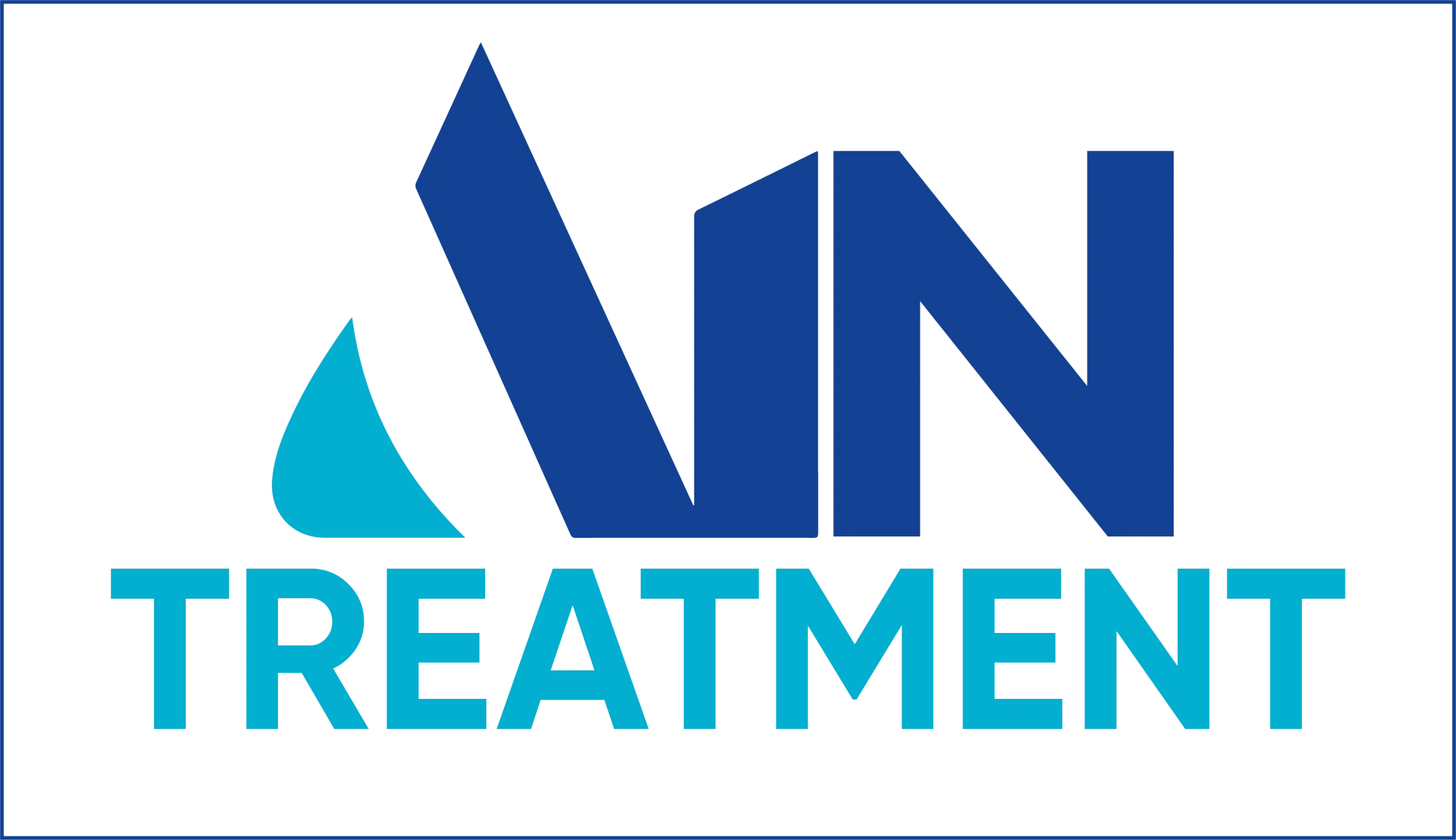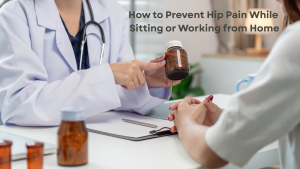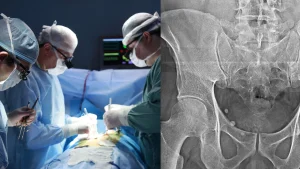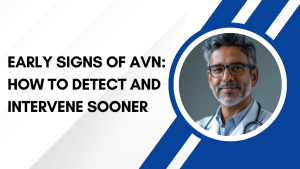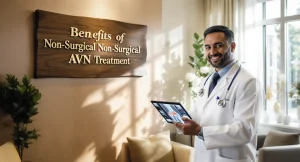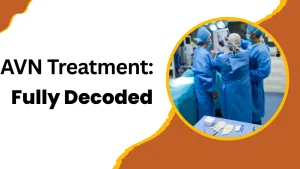AVN Treatment Without Surgery: A Comprehensive Guide
Introduction
Receiving a diagnosis of Avascular Necrosis (AVN), also known as osteonecrosis, can feel like a life-altering event. The words themselves “bone death” are frightening. Your doctor may have explained that the blood supply to a part of your bone, most commonly the head of the femur (the ball in your hip joint), has been cut off, causing the bone tissue to die and collapse.
Often, the conversation quickly turns to surgery. You might hear terms like “core decompression” or the inevitable “total hip replacement.” For many, this path feels overwhelming, raising concerns about major surgery, long recovery periods, and the idea of living with an artificial joint.
But what if surgery wasn’t the only option? What if there was a way to intervene, to restore blood flow, and to help your body heal the damaged bone without invasive procedures?
This is your comprehensive guide to AVN treatment without surgery in India. We will explore the nature of Avascular Necrosis, its stages, and dive deep into the full spectrum of non-surgical treatments available today from conservative management to the revolutionary field of regenerative medicine. Our goal is to empower you with the knowledge to make an informed decision and to show you that for many, there is a powerful and effective path to recovery that doesn’t involve a single scalpel.
What Exactly is Avascular Necrosis? Understanding the Root Cause
Before we can explore the treatments, it’s crucial to understand the problem. Imagine a small, remote village that relies on a single road for all its supplies. If that road gets permanently blocked, the village is cut off and cannot survive. This is precisely what happens in AVN.
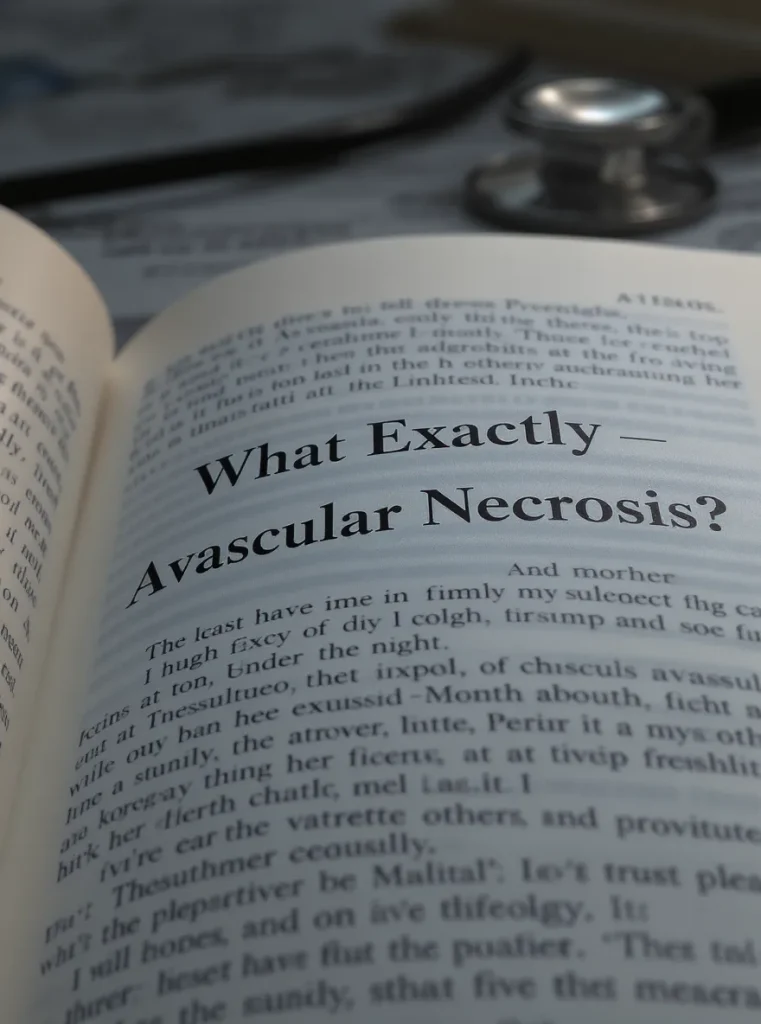
The “village” is a section of your bone. The “road” is the network of tiny blood vessels that supply it with oxygen and nutrients. When this blood supply is compromised for reasons we’ll discuss below the bone cells are starved and begin to die.
As the bone dies, it weakens. In the hip, the rounded, weight-bearing femoral head begins to lose its structural integrity. It can develop microfractures and, eventually, collapse under the body’s weight, much like an eggshell cracking under pressure. This collapse leads to severe pain, joint damage, and the onset of arthritis.
Who is at Risk? The Common Causes of AVN in India
While AVN can sometimes occur without a clear reason (idiopathic AVN), it is often linked to specific risk factors that are particularly relevant in the Indian context:
Steroid Use: The prolonged use of corticosteroid medications (like prednisone) is one of the leading causes of AVN. These are often prescribed for conditions like asthma, autoimmune diseases, or even in some COVID-19 treatments.
Excessive Alcohol Consumption: Heavy alcohol intake has been shown to interfere with the body’s ability to break down fats. These fatty substances can clog the small blood vessels, leading to reduced blood flow to the bones.
Trauma or Injury: A direct injury to the hip, such as a dislocation or fracture, can damage the blood vessels that supply the femoral head.
Medical Conditions: Certain conditions like sickle cell anemia, Gaucher’s disease, and blood clotting disorders can affect blood flow.
The Critical Factor: Understanding the Stages of AVN
Not all AVN cases are the same. The success of any non-surgical treatment is heavily dependent on the stage of the disease at the time of diagnosis. The most common staging system is the Ficat-Arlet classification, which uses X-rays and MRI scans.
Stage I: Pre-clinical & Pre-radiographic
What’s Happening: The blood supply is cut off, and bone death is beginning, but the bone structure is still intact.
Symptoms: You may have little to no pain. The condition is often invisible on an X-ray but can be detected by an MRI.
Non-Surgical Potential: Excellent. This is the golden window for regenerative treatments to restore blood flow and prevent progression.
Stage II: Sclerotic & Cystic Lesions
What’s Happening: The bone has started to react to the damage, but the femoral head has not yet collapsed. X-rays may now show changes.
Symptoms: Pain, especially when putting weight on the hip, is common.
Non-Surgical Potential: Very Good. The primary goal is to halt the disease before any structural collapse occurs. Regenerative therapies are highly effective at this stage.
Stage III: Crescent Sign & Femoral Head Collapse
What’s Happening: The bone has weakened to the point where a small fracture appears just beneath the surface, and the round shape of the femoral head begins to flatten or collapse.
Symptoms: Pain often becomes more constant and severe, and limping may begin.
Non-Surgical Potential: Fair to Good. While more challenging, regenerative treatments can still provide significant pain relief, slow down further collapse, and potentially postpone the need for surgery for many years.
Stage IV: End-Stage Collapse & Arthritis
What’s Happening: The femoral head has fully collapsed, and the damage has spread to the cartilage of the hip socket, leading to severe secondary osteoarthritis.
Symptoms: Chronic, severe pain, stiffness, and significant loss of function.
Non-Surgical Potential: Limited. At this stage, the joint is usually too damaged for regenerative therapies to rebuild it. Treatment focuses on pain management, and a hip replacement is often the most viable long-term solution.
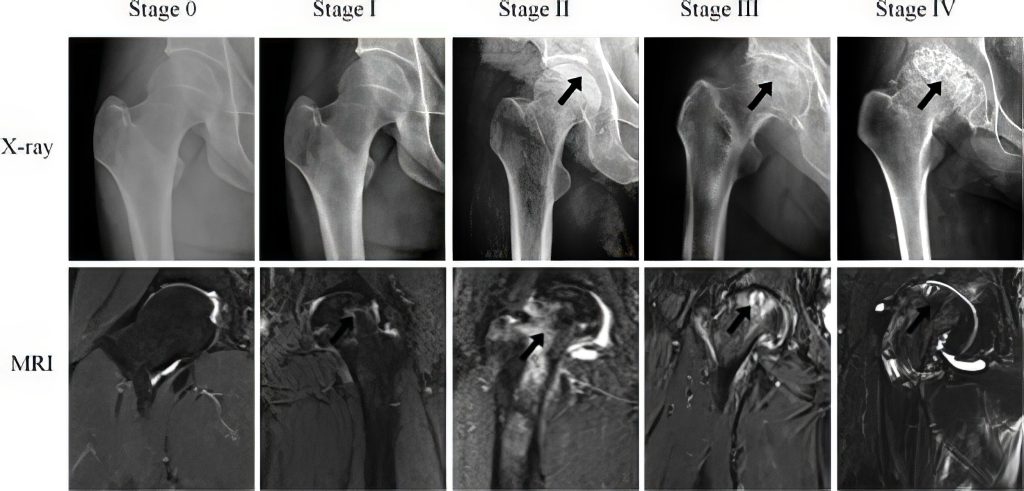
The Spectrum of Non-Surgical AVN Treatments
Now, let’s explore the available non-surgical pathways, starting from the most basic and moving to the most advanced.
1. Conservative Management: Buying Time and Managing Symptoms
These methods do not stop the progression of AVN but can help manage pain in the very earliest stages.
Reduced Weight-Bearing: Using crutches or a walker to take pressure off the affected hip is one of the first recommendations. The goal is to prevent the weakened bone from collapsing under your body’s weight.
Medications:
NSAIDs (Non-Steroidal Anti-Inflammatory Drugs): Medications like ibuprofen can help reduce pain and inflammation. However, they do not affect the disease process itself.
Blood Thinners: In cases where AVN is suspected to be caused by blood clotting issues, these medications may be prescribed.
Physiotherapy: A skilled physiotherapist can design a program of gentle exercises to maintain the range of motion in your hip joint and strengthen the surrounding muscles. This is crucial for supporting the joint but must be done carefully to avoid stressing the weakened bone.
The Limitation: While helpful for comfort, these conservative methods are often just a bridge. They do not address the core problem the lack of blood supply.
2. Medical Intervention: Bisphosphonates
Bisphosphonates are a class of drugs typically used to treat osteoporosis. The theory is that they can help slow down the breakdown of bone, potentially giving the body more time to repair the damaged area in AVN. While some studies have shown modest benefits in very early-stage AVN, their effectiveness is still debated, and it is considered an “off-label” use.
The Regenerative Revolution: Healing AVN from Within
This is where the most exciting and promising non-surgical treatments for AVN lie.
 Regenerative medicine doesn’t just mask the symptoms; it aims to address the root cause of the disease by stimulating the body’s own natural healing mechanisms. The goal is two-fold: restore blood supply (revascularization) and rebuild dead bone (osteogenesis).
Regenerative medicine doesn’t just mask the symptoms; it aims to address the root cause of the disease by stimulating the body’s own natural healing mechanisms. The goal is two-fold: restore blood supply (revascularization) and rebuild dead bone (osteogenesis).
For AVN in Stages I, II, and even early Stage III, regenerative therapies offer the best hope for avoiding surgery.
Introducing Stromal Vascular Fraction (SVF) Therapy
At the forefront of regenerative medicine is Stromal Vascular Fraction (SVF) Therapy. It is a highly advanced, minimally invasive procedure that uses a powerful and concentrated mix of your own body’s healing cells to treat AVN.
What is SVF? It’s More Than Just Stem Cells.
Your body’s adipose (fat) tissue is one of the richest, most accessible sources of regenerative cells. SVF is a potent “cellular cocktail” isolated from this fat tissue. It contains:
Mesenchymal Stem Cells (MSCs): The master controllers of healing. They can differentiate into new bone cells (osteoblasts) and cartilage cells.
Endothelial Progenitor Cells (EPCs): These are the critical cells responsible for forming new blood vessels (a process called angiogenesis). This directly tackles the primary problem of AVN.
Growth Factors & Cytokines: These are signaling molecules that orchestrate the entire healing process, reducing inflammation, recruiting other repair cells, and promoting tissue growth.
The SVF Therapy Process: A Same-Day Procedure
Consultation & Candidacy: A thorough evaluation, including MRI scans, confirms your AVN stage and determines if you are a good candidate.
Cell Collection: The procedure begins with a simple, comfortable mini-liposuction, usually from the abdomen or flank, to collect a small amount of fat tissue. This is done under local anesthesia.
Cell Isolation: The collected fat is then taken to an on-site lab and processed using a specialized sterile system. This process separates the powerful SVF cells from the fat cells, creating a highly concentrated healing injectate.
Precision Injection: Using real-time imaging guidance (like fluoroscopy or ultrasound), the physician precisely injects the SVF concentrate directly into the area of dead bone in the femoral head. This ensures the healing cells are delivered exactly where they are needed most.
Why SVF Therapy is Uniquely Effective for Avascular Necrosis
SVF doesn’t just offer one mode of action; it launches a multi-pronged attack on the disease:
It Creates New Blood Vessels (Angiogenesis): The endothelial progenitor cells get to work forming a new network of micro-vessels, restoring the vital blood supply that the bone has been starved of.
It Prevents Further Bone Cell Death: The growth factors in SVF send signals that stop the existing bone cells from dying off (an anti-apoptotic effect).
It Rebuilds Bone : The mesenchymal stem cells receive signals from the damaged environment and can differentiate into new, healthy bone cells, helping to fill in the necrotic lesion.
It Reduces Painful Inflammation: SVF has a powerful natural anti-inflammatory effect, which provides significant and often rapid pain relief.
For patients with early-stage AVN, this comprehensive healing process offers the potential to not only stop the disease in its tracks but to actually reverse some of the damage, preserving the natural hip joint for years or even a lifetime.
The Critical Comparison: SVF Therapy vs Core Decompression vs. Hip Replacement
To truly understand the value of SVF, let’s compare it directly to the common surgical options.
| Feature | SVF Therapy | Core Decompression Surgery | Total Hip Replacement |
| Goal | Regenerate & Preserve the natural joint | Stimulate healing by relieving pressure | Replace the joint with an artificial one |
| Invasiveness | Minimally invasive (injection) | Invasive (drilling into the bone) | Highly invasive major surgery |
| Anesthesia | Local | General or Spinal | General or Spinal |
| Procedure Time | 2-3 hours, same-day procedure | 1-2 hours, may require overnight stay | 2-3 hours, requires several days in hospital |
| Recovery | Minimal downtime, walking same day | 4-6 weeks on crutches | 3-6 months of intensive physiotherapy |
| Best For | Stages I, II, and early III | Stages I and early II | Late Stage III and Stage IV |
| Source of Healing | Your own body’s concentrated cells | The body’s natural response to injury | An artificial metal & plastic implant |
| Risks | Minimal (local bruising/soreness) | Fracture, infection, nerve damage | Infection, blood clots, dislocation, implant failure |
Life After Minimal invasive Treatment:
Choosing a regenerative path with SVF therapy is the first step. A successful long-term outcome also depends on you. After the procedure, your journey will involve:
A Personalized Physiotherapy Program: This is essential. Your physiotherapist will guide you through exercises that protect the healing joint while progressively strengthening the muscles that support your hip.
Lifestyle Modifications: Addressing the root cause of your AVN is critical. This may mean significantly reducing or eliminating alcohol consumption, working with your primary doctor to manage steroid use, and maintaining a healthy weight to reduce stress on your hips.
Patience and Follow-up: Regenerative medicine works with your body’s natural healing timeline, which takes time. It can be several months before the full benefits are realized. Regular follow-up appointments and imaging will be used to monitor your progress.
Conclusion
Avascular Necrosis is a serious condition, but it is no longer a guaranteed sentence to major surgery. The landscape of medicine has evolved, and the power of your own body to heal is now being harnessed in incredible ways.
For those in the early to moderate stages of AVN, the decision to explore non-surgical treatments like SVF Therapy is a decision to invest in the future of your own natural joint. It offers a scientifically-backed, safe, and powerful alternative that addresses the root cause of the disease, providing a path to lasting pain relief and restored function.
If you have been diagnosed with AVN and told that surgery is your only option, it’s time for a second opinion.
